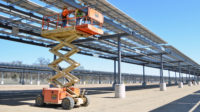Efforts to increase U.S.-based production have boosted manufacturing as the top performer among nonresidential construction segments, according to the Marcum Commercial Construction Index for the fourth quarter of 2022.
Manufacturing construction spending is up 58.2% since the start of the COVID-19 pandemic, compared to a 6.6% increase in overall nonresidential construction spending, according to the report authored by Anirban Basu, chief construction economist for accounting and advisory services firm Marcum LLP. The large scale of many current projects such as semiconductor chip fabrication plants means that the segment should maintain its momentum throughout the year.
Manufacturing construction spending hit a seasonally adjusted annualized rate of $122.7 billion in December.
“A combination of trade tensions, pandemic-induced supply chain anxiety, and a resulting effort to reshore production has led to an array of massive domestic manufacturing projects,” Basu said in a statement.
However, an “overheated” economy with inflation and interest rates continuing to rise elevates the risk of a recession, according to the report. Residential construction has already felt the impact of interest rate hikes, and the elevated borrowing costs will likely impact nonresidential segments too.
Labor shortages remain a major issue facing the industry, Basu says. Construction averaged 390,500 open, unfilled jobs per month in 2022. In December, 5% of construction jobs were unfilled.
“As a result, construction wages are rising at a much faster rate than wages in all industries, further contributing to already-elevated construction costs,” Basu said.
Construction added 24,000 jobs in February, the Bureau of Labor Statistics reported March 10, the day after Marcum released its report.
Health care construction spending rebounded since the fourth quarter of 2021 as projects delayed by the pandemic advanced, with spending in the segment hitting a record high in November, according to the report. Basu projects the segment will retain momentum through at least the first half of this year, though the seasonally adjusted annualized rate of spending in the segment did decline slightly in December to $54.8 billion.
Commercial construction has seen an increase in warehouse and fulfillment projects, with spending up 47.3% since a low point in August 2020, according to the report. While Basu projects the segment will retain momentum early this year, he notes the boom in warehouse projects may be winding down. Commercial construction spending hit a seasonally adjusted annualized rate of $126.7 billion in December.
Power-related construction spending has fared less well than the other segments, with a 7.5% drop over the past year to a seasonally adjusted annualized rate of $107.6 billion in construction spending in December. Basu attributes the drop in part to materials and labor shortages, as well as regulatory hurdles. Power infrastructure projects funded by the Infrastructure Investment and Jobs Act may help the segment, though publicly financed projects account for a small portion of power-related construction spending.






Post a comment to this article
Report Abusive Comment